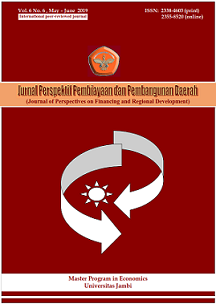Determinant of micro, small and medium enterprises on carrying out a credit loan in Jambi Province
DOI:
https://doi.org/10.22437/ppd.v6i6.6913Abstract
This study aims to analyze the determinant of micro, small and medium enterprises (MSMEs) on carrying out a credit loan. Primary data has been used in the analysis. The population in this study were all MSMEs in Jambi Province. Samples were taken by purposive random sampling. Total sample are 276 consisting of 163 MSMEs actors who took credit and 113 MSMEs actors who did not take credits. To analyze the factors that influence the taking of credits, a binary logit model is used. The dependent variable is the taking of credits, while the independent variables are household characteristics and individual characteristics of MSMEs actors. The results showed that the factors significantly affected the MSMEs on taking credit were the side job variables, working hours, working partners, gender, education, long established business, household expenses and account ownership.
Downloads
References
Abdullah, A., Bilau, A.A., Ajagbe, A.M., & Bustani, S.A. (2012). Small and Medium Sized Construction Firms Job Satisfaction and Performance Evaluation in Nigeria. The International Doctoral Fellowship (IDF) and the Research University Grant. Covenant University.Retrieved from http://eprints.covenantuniversity.edu. ng/4972/ #.XSMeDeszbIU
Anonim. (2010). Program Kemitraan dan Bina Lingkungan pada BUMN. Retrieved from http://www.bumnnews.co/index.php/component/k2/item/45-workshop-implementasi-pkbl-berdasarkan-iso-26000-2010.
Anyiro,C.O & Oriaku, B.N. (2011). Access to and Investment of Formal Micro Credit by Small Holders Farmers in Abia State, Nigeria. A Case Study of ABSU Micro Finance Bank, UTURU. The Journal of Agricultural Sciences, 6(2), 69 – 76
Azriani, Z. (2014). Aksessibilitas dan Partisipasi Industri Kecil dan Rumahtangga Pada Pembiayaan dan Pengaruhnya Terhadap Kinerja Usaha dan Kesejahteraan Rumahtangga Di Kabupaten Bogor Jawa Barat. Thesis. Bogor: Sekolah Pascasarjana Institut Pertanian Bogor.
Balogun, O. A., Nazeem, A., & Agumba, J. N. (2016). Determinants Predicting Credit Accessibility within Small and Medium-sized Enterprises in the South African Construction Industry. Procedia Engineering, 164, 473–480.
Bank Indonesia. (2014). Kredit UMKM. Retrieved from http://www.bi.go.id/ id/umkm/ kredit/ Contents/Default.aspx
Becker, G.S. (1976). The Economic Approach to Human Behavior. Chicago: The University of Chicago Press
Farida. 2015. Analisa Kinerja Usaha Rakyat Dan Dampaknya Terhadap Pendapatan Usaha Mikro Di Kabupaten Pati Jawa Tengah. Thesis. Bogor: Sekolah Pasca Sarjana Institut Pertanian Bogor.
Farinha, L., & Félix, S. (2015). Credit rationing for Portuguese MSMEs. Finance Research Letters, 14, 167–177
Juanda, B. (2009). Ekonometrika Pemodelan dan Pendugaan. Bogor: IPB Press
Junaidi. (2015). Model Regresi Binary Logit (Aplikasi Model Dengan Program SPSS). Retrieved from https://www.researchgate.net/publication/278093773
Kausar, A. (2013). Factors Affect Microcredit‟s Demand in Pakistan. International Journal of Academic Research in Accounting, Finance and Management Science, 3(4), 11-17
Kementerian Koperasi dan Usaha Kecil dan Menengah. (2015). Blueprint Pembiayaan Koperasi, Usaha Mikro, Kecil dan Menengah Tahun 2015-2019. Jakarta: Kementerian Koperasi dan Usaha Kecil dan Menengah
Kementerian Badan Usaha Milik Negara Republik Indonesia. (2015). Tiga Perubahan di PERMEN PKBL 2015. Jakarta: Kementerian Koperasi dan Usaha Kecil dan Menengah
Li, X,, Gan, C,, & Hu, B. (2011). Accessibility to Microcredit by Chinese Rural Household. Journal of Asian Economics, 22, 235-246.
Messah,O.B, & Wangai. (2011). Factors that Influence the Demand for Credit Among Small-Scale Investors : a Case Study of Meru Central District, Kenya. Research Journal of Finance and Accounting, 2(2), 74 – 101
Nakajima, C. (1986). Subjective Equilibrium Theory of the Farm Household. Amsterdam: Elsevier Science Publishers
Nguyen, N & N. Luu. (2013). Determinants of Financing Pattern and Access to Formal-Informal Credit: The Case of Small and Medium Sized Enterprises in Viet Nam. Journal of Management Research, 5 (2): 240-259.
Nuswantara, B. (2012). Peranan Kredit Mikro dan Kecil Terhadap Kinerja Usaha Kecil Dan Ekonomi Wilayah Di Propinsi Jawa Tengah. Thesis. Sekolah Pascasarjana, Institut Pertanian Bogor, Bogor.
Ololade, R.A., & Olagunju F.I. (2013). Determinants of Access to Credit among Rural Farmers in Oyo States, Nigeria. Global Journal of Science Frontier Research Agriculture and Veterinary Science, 13(2), 17 – 22
Oriakhi, H.O., and E.A. Onemolease. (2012). Determinants of Rural Household’s Willingness to Participate in Community Based Health Insurance Scheme in Edo State, Nigeria. Ethno Med, 6(2): 95-102
Pandula, G. (2011). An Empirical Investigation of Small and Medium Enterprise’s Access to Bank Finance, ASBBS Annual Conference Procceding, 18 (2).
Downloads
Published
How to Cite
Issue
Section
License
Copyright (c) 2019 Etik Umiyati, Amri Amir, Haryadi Haryadi, Zulfanetti Zulfanetti

This work is licensed under a Creative Commons Attribution 4.0 International License.

















